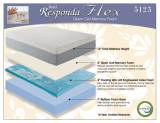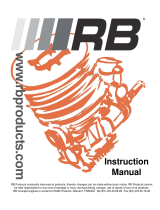
T-MAXX 3.3 OWNER’S MANUAL
•
3
SAFETY PRECAUTIONS
All of us at Traxxas want you to safely enjoy your new T-Maxx 3.3. Operate
your T-Maxx 3.3 sensibly and with care, and it will be exciting, safe, and
fun for you and those around you. Failure to operate your T-Maxx 3.3 in a
safe and responsible manner may result in property damage and serious
injury. The precautions outlined in this manual should be strictly followed
to help ensure safe operation. You alone must see that the instructions are
followed and the precautions are adhered to.
Important Points to Remember
• T-Maxx 3.3 is very fast! The T-Maxx 3.3 is intended for experienced
users with a high level of skill. The TRX 3.3 Racing Engine is extremely
powerful and may require skilled driving to maintain control.
• The engine, brakes, and exhaust system may become extremely hot
during use. Be careful not to touch the parts, especially when refueling
or stopping the engine.
• Model engine fuel is dangerous and highly poisonous. Always follow
all directions and precautions printed on the fuel container. Model
engine fuel is poisonous to humans and animals. Drinking the fuel can
cause blindness and death. Handle with care and respect.
• Model engine fuel, especially when in a fuel dispensing bottle, may
look like a cool drink to a child. Keep all fuel out of the reach of
children at all times. Do not place fuel containers on the ground
where children can reach them while you are driving.
• Model engine fuel is flammable. Never allow smoking, sparks, heat
or flame in the presence of fuel or fuel vapors.
• Prolonged exposure to the engine exhaust can be harmful. Avoid
breathing the engine exhaust. Always run your T-Maxx 3.3 outdoors, in
a well-ventilated area. Never run the engine indoors.
• Do not operate your T-Maxx 3.3 at night, or anytime your line of sight
to the model may be obstructed or impaired in any way.
• Never operate your T-Maxx 3.3 in crowds of people or busy pedestrian
areas. T-Maxx 3.3 is very fast and could cause injury to those unaware
of its presence. Keep small children at a safe distance away from the
operating area.
• Because T-Maxx 3.3 is controlled by radio, it is subject to radio
interference from many sources beyond your control. Since radio
interference can cause momentary loss of control, always allow a safety
margin in all directions around your model to prevent collisions.
• The engine can be loud. If the noise makes you uncomfortable, wear
ear protection. Be considerate of your neighbors by not running your
model early in the morning or late in the evening.
• Most importantly, use good common sense at all times.
Children (minors) under 16 years of age and inexperienced
drivers should not operate the T-Maxx 3.3 without the supervision
of a responsible and knowledgeable (experienced) adult.
Batteries and Battery Charging
Your model uses rechargeable batteries that must be handled with
care for safety and long battery life. Make sure to read and follow all
instructions and precautions that were provided with the battery packs
and your charger. It is your responsibility to charge and care for the battery
packs properly. In addition to your battery and charger instructions, here
are some more tips to keep in mind.
• Use the supplied charger to charge the included battery. See “Charging
the EZ-Start Battery” on page 17.
• Do not charge batteries inside of an automobile. Do not charge batteries
while driving in an automobile. The charger is equipped with a long cord
intended to allow the battery to be charged outside of an automobile
when using the automobile’s auxiliary power socket. If the cord will not
reach outside of the automobile, find another power source.
• Never leave batteries to charge unattended.
• Allow the battery pack to cool off before charging.
• Do not use battery packs that have been damaged in any way. Do
not use battery packs that have damaged wiring, exposed wiring, or a
damaged connector as this may create the risk of fire.
• Children should have responsible adult supervision when charging and
handling batteries.
• Never charge batteries on wood, cloth, carpet or on any other
flammable material.
• Do not operate the charger in a cluttered space, or place objects on top
of the charger or battery.
• If a battery gets hot to the touch during the charging process
(temperature greater than 140°F / 60°C), disconnect the battery from
the charger and discontinue charging immediately.
• Always store battery packs safely out of the reach of children and pets.
• Do not expose the charger to water or moisture.
• Do not disassemble the charger.
• Only use approved chargers for Nickel Metal Hydride (NiMH) battery
packs.
• Do not short-circuit the battery pack. This may cause burns and severe
damage to the battery pack.
• Do not burn or puncture the batteries. Toxic materials could be
released. If eye or skin contact occurs, flush with water.
• Store the battery pack in a dry location, away from heat sources and
direct sunlight.
• NiMH batteries must be recycled or disposed of properly.
Recycling Your Traxxas Power Cell NiMH Battery
Traxxas strongly encourages you to recycle your Power Cell NiMH
battery when it has reached the end of its useful life. Do not throw your
battery in the trash. All Power Cell NiMH battery packs display the RBRC
(Rechargeable Battery Recycling Corporation) icon, indicating they are
recyclable. To find a recycling center near you, ask your local hobby
dealer or visit www.call2recycle.org.dealer or visit www.call2recycle.org.
Entire contents ©2020 Traxxas. Traxxas, Maxx, T-Maxx 3.3, TRX 3.3 Racing Engine, TQi, Top Fuel,
EZ-Start, Ready-To-Race, Ready-To-Win, and ProGraphix are trademarks or registered trademarks
of Traxxas. Other brand names and marks are the property of their respective holders and are
used only for purposes of identification. No part of this manual may be reproduced or distributed
in print or electronic media without the express written permission of Traxxas.
Traxxas
6250 Traxxas Way
McKinney, TX 75070
Phone: 972-549-3000
Toll-free 1-888-TRAXXAS
Internet: Traxxas.com
INTRODUCTION
FCC Compliance
This device contains a module that complies with the limits for a Class B digital device as described in part 15 of the FCC rules. Operation is subject to the following two conditions: (1) This device may not cause harmful
interference, and (2) this device must accept any interference received, including interference that may cause undesired operation.
The limits for a Class B digital device are designed to provide reasonable protection against harmful interference in residential settings. This product generates, uses and can radiate radio frequency energy, and, if not
operated in accordance with the instructions, may cause harmful interference to radio communications. The user is cautioned that changes or modifications not expressly approved by the party responsible for compliance
could void the user’s authority to operate the equipment.
Canada, Industry Canada (IC)
This Class B digital apparatus complies with Canadian ICES-003 and RSS-210. This device complies with Industry Canada license exempt RSS standard(s). Operation is subject to the following two conditions: This device may
not cause interference, and This device must accept any interference, including interference that may cause undesired operation of the device.
Radio Frequency (RF) Exposure Statement
This equipment complies with radio frequency exposure limits set forth by FCC and Industry Canada for an uncontrolled environment. This equipment should be installed and operated with a minimum distance of 20
centimeters between the radiator and your body or bystanders and must not be co-located or operating in conjunction with any other antenna or transmitter.
Operation Frequency: 2414~2453 MHz
Maximum Radio Frequency Power: Maximum Peak Power 9.7 dBm























